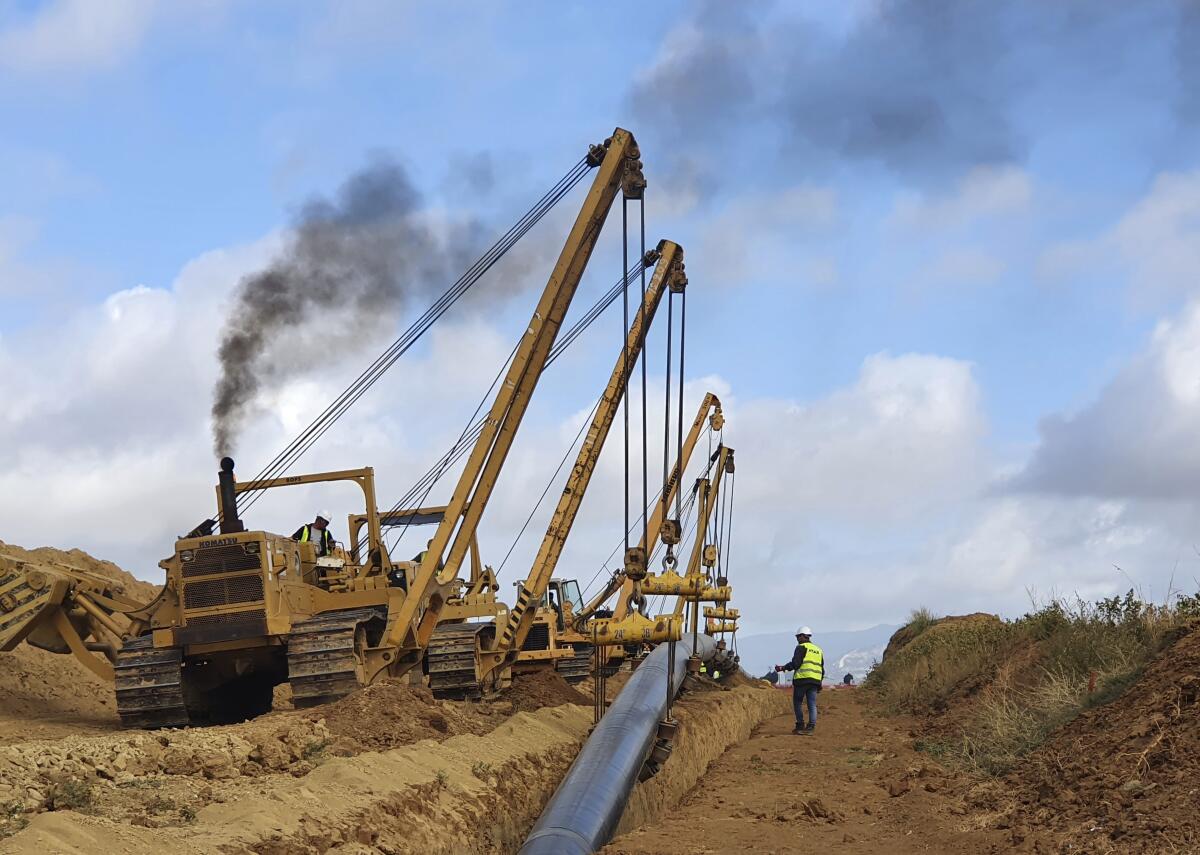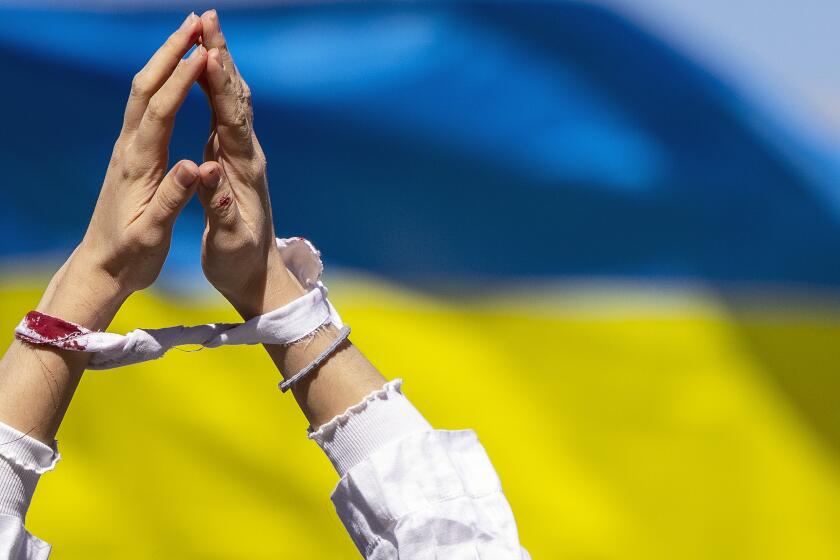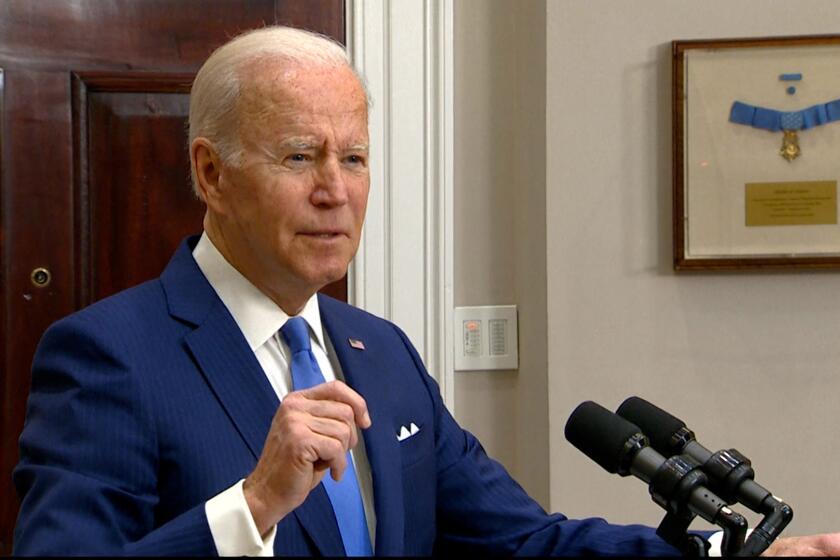A new gas pipeline boosts Europe’s bid to ease dependence on Russia

- Share via
ATHENS — Mountainous and remote, the Greek-Bulgaria border once formed the southern corner of the Iron Curtain. Today, it’s where the European Union is redrawing the region’s energy map to ease its heavy reliance on Russian natural gas.
A new pipeline — built during the COVID-19 pandemic, tested and due to start commercial operation in June — will ensure that large volumes of gas will flow between the two countries to generate electricity, fuel industry and heat homes.
The energy link has taken on greater importance following Moscow’s decision this week to cut off natural gas supplies to Poland and Bulgaria over a demand for ruble payments in response to Western sanctions over the war in Ukraine.
The 110-mile project is the first of several planned gas interconnectors that will give eastern members of the EU — and neighboring nations hoping to join the bloc — access to the global gas market.
In the short term, it’s Bulgaria’s backup. The pipeline connection will give the country access to ports in neighboring Greece that are importing liquefied natural gas, or LNG, and also will bring gas from Azerbaijan through a new pipeline system that ends in Italy.
It’s one of many efforts as the EU’s 27 member states scramble to revise their energy mix, with some reverting to emissions-heavy coal while also planning for more from renewable sources. Germany, the world’s biggest buyer of Russian energy, is looking to build LNG import terminals, although that will take years. Italy, another top Russian gas importer, has reached deals with Algeria, Azerbaijan, Angola and Congo for gas supplies.
Poland has taken in more Ukrainian refugees than all other countries combined. In Warsaw, where 300,000 arrived, a city’s life is transformed.
The EU wants to reduce its dependence on Russian oil and gas by two-thirds this year and completely over five years through alternative sources, wind and solar, and conservation.
Russia’s invasion of Ukraine is likely to accelerate changes in the EU’s long-term strategy, encouraging the bloc to switch to energy that is more expensive but more integrated among member states, said Simone Tagliapietra, an energy expert and research fellow at the Brussels-based Bruegel think tank.
“It’s a new world,” Tagliapietra said. “And in this new world, it’s clear that Russia doesn’t want to be part of an international order as we think of it.”
He added: “The strategy — particularly by Germany — over the last 50 years was always one of engaging with Russia on energy.... But given what we are seeing in Ukraine and given Russia’s view of international relations, it’s not the kind of country with which we would like to do business.”
In a country that has harbored deeply pacifist beliefs since the end of World War II, a majority of Germans oppose taking a tougher stance against Russia.
EU policymakers contend that, while Eastern European members are some of the most dependent on Russian gas, the size of their markets makes the problem manageable. Bulgaria imported 90% of its gas from Russia but consumes only 3 billion cubic meters each year — 30 times less than Germany, according to 2020 data from Eurostat, the EU statistics agency.
Officially called the Gas Interconnector Greece-Bulgaria, the new pipeline will supplement the existing European network. Much of that dates to the Soviet era, transporting gas from vast energy fields in Russia westward, when Moscow sought badly needed funds for its faltering command economy and Western suppliers to help build its pipelines.
The link will run between the northeastern Greek city of Komotini and the central Bulgarian city of Stara Zagora, and will give the countries new grid connections for access to the expanding global gas market. That includes a connection to the newly built Trans Adriatic Pipeline carrying gas from Azerbaijan as well as suppliers of liquefied natural gas that arrives by ship, from places likely to include Qatar, Algeria and the U.S.
As many as eight additional interconnectors could be built in Eastern Europe, reaching as far as Ukraine and Austria.
President Biden vows anew that the U.S. is committed to ensuring Ukraine’s ultimate victory against Russia in a war likely to drag on for months.
The $250-million pipeline will carry 3 billion cubic meters of gas per year, with an option to be expanded to 5 billion. It received funding from Bulgaria, Greece and the EU and has strong political support from Brussels and the United States.
On the ground, the project faced multiple holdups because of supply-chain snags during the COVID-19 pandemic.
Receiving specialized parts and moving personnel after construction got underway in early 2020 soon became increasingly difficult, said Antonis Mitzalis, executive director of the Greek contractor AVAX, which oversaw the project.
Construction finished in early April, he said, while work and testing at two metering stations and software installation are in the final stages.
News Alerts
Get breaking news, investigations, analysis and more signature journalism from the Los Angeles Times in your inbox.
You may occasionally receive promotional content from the Los Angeles Times.
“We had a sequence in mind. But the fact that some materials did not arrive made us rework that sequence, sometimes with a cost effect,” Mitzalis said.
Greek Prime Minister Kyriakos Mitsotakis missed a tour of the site last month after contracting COVID-19. He spoke Wednesday with his Bulgarian counterpart, Kiril Petkov, to provide assurances of Greek support.
“Bulgaria and Greece will continue to work together for energy security and diversification — of strategic importance for both countries and the region,” Petkov later tweeted. “We both are confident for the successful completion of the IGB on time.”
More to Read
Sign up for Essential California
The most important California stories and recommendations in your inbox every morning.
You may occasionally receive promotional content from the Los Angeles Times.












